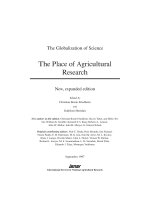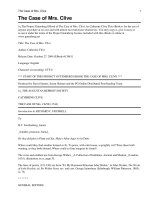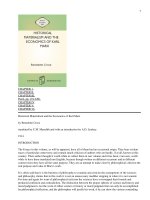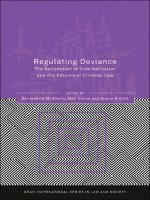Ofcom- The effectiveness of converged regulation ppt
Bạn đang xem bản rút gọn của tài liệu. Xem và tải ngay bản đầy đủ của tài liệu tại đây (703.4 KB, 109 trang )
For More Information
Visit RAND at www.rand.org
Explore RAND Europe
View document details
Support RAND
Browse Reports & Bookstore
Make a charitable contribution
Limited Electronic Distribution Rights
is document and trademark(s) contained herein are protected by law as indicated in a notice
appearing later in this work. is electronic representation of RAND intellectual property is
provided for non-commercial use only. Unauthorized posting of RAND electronic documents to
a non-RAND Web site is prohibited. RAND electronic documents are protected under copyright
law. Permission is required from RAND to reproduce, or reuse in another form, any of our research
documents for commercial use. For information on reprint and linking permissions, please see
RAND Permissions.
Skip all front matter: Jump to Page 16
e RAND Corporation is a nonprot institution that helps improve policy and
decisionmaking through research and analysis.
is electronic document was made available from www.rand.org as a public
service of the RAND Corporation.
CHILDREN AND FAMILIES
EDUCATION AND THE ARTS
ENERGY AND ENVIRONMENT
HEALTH AND HEALTH CARE
INFRASTRUCTURE AND
TRANSPORTATION
INTERNATIONAL AFFAIRS
LAW AND BUSINESS
NATIONAL SECURITY
POPULATION AND AGING
PUBLIC SAFETY
SCIENCE AND TECHNOLOGY
TERRORISM AND
HOMELAND SECURITY
This product is part of the RAND Corporation technical report series. Reports may
include research findings on a specific topic that is limited in scope; present discussions
of the methodology employed in research; provide literature reviews, survey instru-
ments, modeling exercises, guidelines for practitioners and research professionals, and
supporting documentation; or deliver preliminary findings. All RAND reports un-
dergo rigorous peer review to ensure that they meet high standards for research quality
and objectivity.
Ofcom: the effectiveness
of converged regulation
Emily Scraggs, Jonathan Cave, Christian van Stolk,
Dimitris Potoglou, Simo Goshev, Mihaly Fazekas,
Siobhán Ní Chonaill, Barbara Janta, Laura Brereton
Prepared for the Naional Audit Office
EUROPE
RAND Europe is an independent, not-for-profit research organisation whose mission is
to improve policy and decision making for the public good. RAND’s publications do not
necessarily reflect the opinions of its research clients and sponsors.
R
®
is a registered trademark.
© Copyright 2012 RAND Corporation
Permission is given to duplicate this document for personal use only, as long as it
is unaltered and complete. Copies may not be duplicated for commercial purposes.
Unauthorized posting of RAND documents to a non-RAND website is prohibited. RAND
documents are protected under copyright law. For information on reprint and linking
permissions, please visit the RAND permissions page (
permissions.html).
Published 2012 by the RAND Corporation
1776 Main Street, P.O. Box 2138, Santa Monica, CA 90407-2138
1200 South Hayes Street, Arlington, VA 22202-5050
4570 Fifth Avenue, Suite 600, Pittsburgh, PA 15213-2665
Westbrook Centre, Milton Road, Cambridge CB4 1YG, United Kingdom
RAND URL:
RAND Europe URL: />To order RAND documents or to obtain additional information, contact
Distribution Services: Telephone: (310) 451-7002;
Fax: (310) 451-6915; Email:
The research described in this document was prepared for the National Audit Office.
iii
Preface
As part of a wider study to evaluate the effectiveness of Ofcom as a converged regulator,
the National Audit Office commissioned RAND Europe to undertake comparative
research on Ofcom in relation to communications regulators in other jurisdictions. This
work began in February 2010 and was completed in July 2010. This report presents the
findings of the research conducted on five case study areas as follows:
Next generation access networks (NGAN)
Access in the context of local loop unbundling (LLU)
Access to emergency services over voice-over internet protocol (VOIP)
Spectrum planning at the Olympics
Management of mobile mis-selling.
The report consists of the following parts:
Executive summary which focuses on the key findings and conclusions
Synthesis and analysis of the key themes emerging from the case study analysis
Detailed description of the key findings in each of the case studies (in the appendices).
The findings are based on a review of the relevant literature in each country and follow-up
interactions with experts in those countries.
The study will be of interest to those researching communications regulation in the UK
and internationally.
RAND Europe is an independent not-for-profit policy-research organisation whose
mission is to help improve policy and decision-making through research and analysis. We
realise our mission by undertaking objective, balanced, relevant research and analysis,
sharing insights and information widely, working in partnership with our clients and
working collaboratively. This report has been peer reviewed in accordance with RAND’s
quality assurance standards (see:
Ofcom: the Effectiveness of Converged Regulation RAND Europe
i
v
For more information about RAND Europe or this document, please contact:
Dr Emily Scraggs or Dr Christian van Stolk
RAND Europe
Westbrook Centre
Milton Road
Cambridge CB4 1YG
United Kingdom
Tel. +44 (1223) 353 329
v
Contents
Preface iii
List of figures and tables vii
Summary ix
CHAPTER 1 Introduction 1
CHAPTER 2 Methodology 6
CHAPTER 3 Synthesis of key findings in case studies 9
3.1 Introduction 9
3.2 Next generation access (NGA) 9
3.3 Local loop unbundling 13
3.4 Voice-over internet protocol access to emergency services 19
3.5 Spectrum planning for the 2012 London Olympics 23
3.6 Mobile mis-selling 28
REFERENCES 33
List of references 35
APPENDICES 43
Appendix A: Acronyms, glossary, regulators and other organisations 45
Appendix B: Methodology 53
Appendix C: Background and context 57
Appendix E: Access – local loop unbundling case study 71
Appendix F: Voice-over internet protocol case study 77
Appendix G: Spectrum Olympics case study 85
Appendix H: Mobile mis-selling case study 93
vii
List of figures and tables
Table 1.1: Separation of communication regulation functions in main case study
countries 3
Table 2.1: Benchmarks for each case study area 6
Table 3.1: Summary of next generation access networks case study 13
Figure 3.1: Evolution of local loop unbundling in the EU case studies 17
Figure 3.2: Number of unbundled lines 17
Table 3.2: Summary of local loop unbundling case study 19
Table 3.3: Summary of voice-over internet protocol emergency service access case
study 22
Table 3.4: Summary of Olympic spectrum policy case study 28
Table 3.5: Summary of mobile mis-selling case study 31
Table A.1: Acronyms and glossary 52
Table A.2: Regulators and other international/domestic
organisations…………………………………………………………
……… 57
Table B.1: Case studies and countries 53
Table B.2: Characteristics of potential case studies 54
Table B.3: Topics covered within templates 55
Table D.1: Next generation fixed-line access network technologies 63
Table D.2: Next generation wireless access network technologies 65
Figure E.1: Evolution of local loop unbundling in the EU case studies 72
Figure E.2: Number of unbundled lines 72
ix
Summary
This report provides some indications of the performance of Ofcom
compared to other national communications regulators
This report sets out the findings of research commissioned by the National Audit Office
(NAO) and undertaken by RAND Europe between February and July 2010.
The main focus of this research was to provide an assessment of the success with which
Ofcom has delivered regulatory outcomes by comparing them with other national
communications regulators in other countries. The purpose of the research was to put the
performance of Ofcom in an international context and to see whether Ofcom can draw
any lessons from the approaches taken and operational capacities developed by other
regulators.
The findings of the report are based on a series of specific case studies reflecting particular
policy areas. These were jointly selected by the NAO, the study team and Ofcom; as a
result they do not represent either a comprehensive or a random sample of the areas in
which Ofcom is active. The case studies are instead indicative of Ofcom’s performance,
and consist of the following:
Next generation access networks (NGAN)
Access in the context of local loop unbundling (LLU)
Access to emergency services over voice-over internet protocol (VOIP)
Spectrum planning for the London 2012 Olympics
Management of mobile mis-selling,
National regulators play varied roles reflecting different remits and
responsibilities
Ofcom was formed as a single converged regulator, overseeing the broader
communications market, including access, distribution, content and price and co-
ordination of all the relevant regulatory activity.
Many jurisdictions have adopted various different converged forms of regulation that adapt
to the challenges posed by convergence through different mechanisms (varying by issue
and country). These typically involve merging telecommunications and content regulation
(e.g. in Australia, Canada, Finland, Iceland, Italy, Japan, Luxemburg, the United Kingdom
Ofcom: the Effectiveness of Converged Regulation RAND Europe
x
and the United States). Increasingly, there is a trend to include other regulatory areas as
well, especially as regulatory concerns arising in one sector spill over into others. There is a
variety of models, including the following:
Converged regulators – regulatory entities that oversee a range of services which
include telecommunications and information and communications technologies,
including broadcasting.
Multi-sector regulatory authorities – these regulate various industry sectors that are
considered public utilities, such as telecommunications, water, electricity and
transportation.
Use of general regulatory powers (e.g. competition) to provide the primary regulatory
oversight over the telecommunications and related sectors.
The strategies chosen by Ofcom often reflect its distinct remit and the
particularities of the UK market and European regulatory environments
Relatively few regulators cover the same range of sectors and issues as Ofcom; therefore
direct comparisons must be placed in context. In particular, Ofcom evolved as a converged
regulator simultaneously with the convergence of the sector(s) involved, the successive
refinement and reform of the overall EU Telecommunications Regulatory Framework and
the development of alternative forms of regulatory convergence in European Member
States.
Ofcom’s performance and influence on UK/EU markets can thus be seen in the structure
as well as the conduct and performance of UK telecommunications and in the broader
European regulatory and market environment. This external influence addresses Ofcom’s
statutory duties by altering the Europe-wide sector context within which are both UK-
based firms and firms based elsewhere in Europe but operating or offering services in the
UK.
Case study findings
Next generation access networks
NGAN is the network through which we access communication technology; NGANs refer
broadly to the development of new network technologies, and to access infrastructures and
even services – but narrowly to a specific network architecture (and related equipment)
that uses a common internet protocol (IP) core network for all (past, present and future)
access networks.
In terms of strategic planning for NGANs, Sweden and France are pursuing explicit
planned strategies, while the UK and The Netherlands are allowing the market to lead the
direction. This may produce at least short-term variation in the mix of technologies (and
capabilities) used. Ofcom is consulting broadly on the issues involved. There is no
geographical coverage plan in place in the UK. While the UK does not have a specific
planned direction for NGANs, at present it is not unduly disadvantaged by this. However,
there are fears of a digital divide growing between rural and urban communities.
RAND Europe
xi
Local loop unbundling
LLU refers to a variety of methods intended to facilitate competition. It may take various
forms, ranging from full unbundling to IP-based (bitstream) access. There are various
measures of the extent to which LLU has been achieved (in terms of, e.g., number and
percentage of lines ‘unbundled’ in the full, shared-line or bitstream senses, proportions of
traffic) and relatively few data showing the subsequent impact in terms of competition,
price reductions and/or quality improvements.
Germany and France were ahead in the adoption of LLU, having introduced LLU prior to
EU enforcement. Despite this, more providers have taken advantage of LLU in the UK
than in other countries. In terms of opening access via LLU, the UK lagged well behind its
European Commission (EC) competitors in LLU (if bitstream is excluded), though it was
well in the lead throughout this period if bitstream is included. Overall, Ofcom had the
advantage of observing the decisions taken by other national regulatory authorities
(NRAs). The infrastructural investment implications of this have yet to be determined.
VOIP access to emergency services
VOIP refers in general to the carriage of voice telephony over IP networks. Because our
focus here is on emergency service access, we primarily consider VOIP providers offering
connections to the public switched telephone network (PSTN). VOIP emergency service
access forms a part of the more general issue of regulating VOIP services.
The USA has led the way in imposing emergency call access and location information
requirements, despite treating VOIP as an information service. Many of the other
countries considered have treated VOIP as a telephone service, but have adopted a light-
touch regulatory regime. France was one of the pioneers in developing VOIP policy, but
this did not translate into leadership in relation to emergency access. Ofcom stood out not
only in explicitly considering emergency service access, but also in developing an interim
forbearance policy that encouraged entrants to provide emergency service access and only
later added location information requirements.
The current EC regulatory framework follows the UK lead in the sense that it emphasises a
light regulatory touch, taking into account the emerging nature of the technology, whilst
preserving consumer interests – especially in relation to emergency service access. Ofcom
has therefore played a leadership role here to some extent.
Spectrum planning for Olympics
In each of the four Olympic Games included in this analysis (London 2012, Vancouver
2010, Beijing 2008 and Athens 2004) spectrum provision plans were put in place ahead of
time.
We can see that as the Olympics progress, the planning, organisation and management of
spectrum-related issues is becoming more elaborate and more comprehensive. Increasingly,
collaboration is needed across groups of stakeholders and the NRAs are becoming more
critical in the role that they play.
Ofcom is dealing with more spectrum demand and more complexity for London 2012
than has been required for any previous Olympic Games. The planning and extent of the
testing show that Ofcom has learned where possible from previous events and is well
positioned for the challenges ahead.
Ofcom: the Effectiveness of Converged Regulation RAND Europe
xii
Mobile mis-selling
For the purposes of this study, mobile mis-selling is defined (based on a UK definition) as
having three main elements. These are, first, general mis-selling in which, for example, a
customer is given false information; secondly, ‘slamming’, which relates to a substantial
contract or provider change without informed consent; and, thirdly, cashback offers, in
which the customer is promised refunds after the purchase that are impossible to get.
Looking at the extent of these mis-selling problems, in the UK we can see that there has
been a dramatic reduction in the number of instances between 2007 and 2009.
From the perspective of the consumer, in the UK mobile mis-selling is a reducing problem
and therefore the public is less exposed to these specific issues. In Australia problems
remain for consumers although there is awareness of them on the part of the
Telecommunications Industry Ombudsman (TIO) and the regulators. In Israel the
consumer protection approach seems to be working by keeping track of complaints and
suggesting specific changes to the processes, as needed.
Cross-cutting findings
The case studies broadly indicate that Ofcom performs well compared to other national
regulators, though a few areas of concern remain.
Despite these limitations, the case studies yielded the following cross-cutting findings:
Ofcom is one of the thought leaders internationally in mobile mis-selling and
emergency access to VOIP areas;
Ofcom stands out in its ability to engage with stakeholders and draw lessons from
previous Olympics as it plans spectrum allocation for London 2012;
Ofcom’s decisions in LLU and NGAN to follow the market initially rather than have a
planned strategy to drive these in a particular direction have up to this point not
disadvantaged the UK, though the implications for long-term investment in
infrastructure and provision of services to remote areas remain unclear.
1
CHAPTER 1 Introduction
This report sets out the findings of research commissioned by the NAO and undertaken by
RAND Europe between February and April 2010.
1
The main focus of this research was to provide an assessment of the success with which
Ofcom has delivered regulatory outcomes by comparing them with the activities of other
communications regulators in other countries. The purpose of the research was to put the
performance of Ofcom in an international context and to see whether Ofcom can draw
any lessons from the approaches taken and operational capacities developed by other
regulators. The comparison provided here was not meant to be comprehensive but instead
indicative, focusing on a number of regulatory areas.
Ofcom was created in 2002 and vested in 2003, as the product of a merger of five legacy
regulators that were in related fields, with some overlapping responsibilities. Since then it
has had two main areas of responsibility: to further the interests of citizens in relation to
communication matters and to further the interests of consumers in relevant markets
where appropriate through competition. The NAO published a study in 2006
2
on the
costs and challenges arising from the creation of Ofcom. That study reviewed the decision-
making process behind the creation of Ofcom and how the merger was carried out, and
undertook an early review of the extent to which it had achieved its high-level objectives.
The present research updates the previous assessment of Ofcom as a converged regulator
with a particular focus on the regulatory outcomes delivered.
1.1 Ofcom as a single converged regulator oversees access,
distribution, content and price in the communications sector
Ofcom was intended to be a single converged regulator, overseeing the broader
communications market, including access, distribution, content and price. With the
communications sector generating revenue of £36 billion in 2003 and modes of
communication increasingly overlapping, it was a logical step to create a new style
regulator that would co-ordinate all the relevant regulatory activity.
1
A glossary is provided in Appendix A that contains explanations of all relevant acronyms and terms used in
the report.
2
NAO (2006) The creation of Ofcom: wider lessons for public-sector mergers of regulatory agencies, HC: 1175
2005–2006, The Stationery Office.
Ofcom: the Effectiveness of Converged Regulation RAND Europe
2
This new converged communications environment was a significant shift from what had
gone before. In the past, broadcast and telecommunications were clearly separate markets,
based on different technologies, with distinct governance and regulatory frameworks.
Broadcasting often had a strong public-sector interest, driven by concerns about free
speech, diversity of supply, decency, programming (cultural content, sports and major
events), advertisements, objective information provision, protection of minors and so on.
Public broadcasters were supervised by content boards or similar institutions, ensuring that
the supply of content services complied with the desired societal objectives. Through
media ownership restrictions and other rules these were extended to commercial
broadcasting services. Telecommunications markets were ruled by economic and technical
issues, including network access; the public interest was the derived goal of ensuring
affordable services to everyone. Telecommunication markets, which were mostly liberalised
in the 1990s, usually had a regulator to ensure that neither the natural monopoly nor the
technical characteristics of incumbent operator(s) would be used to restrict network access
or otherwise be exploited to create and abuse significant market power.
1.2 Regulators play varied roles reflecting different remits and
responsibilities
Across the countries included in the case studies within this research, regulators play a
varied role with a number of different responsibilities and remits. The extent to which
there is separation of functions in the context of communications regulation in the main
case study countries is presented in Table 1.1 below (a full table with regulatory
competences is provided in Appendix B; see Table B.2).
RAND Europe
3
Table 1.1: Separation of communication regulation functions in main case study countries
3
Countr
y
Telecom
carriage
Telecom
spectrum
Broadcast
carriage
Broadcast
spectrum
Content
Australia ACMA
France ARCEP ARCEP Conseil
supérieur de
l'audiovisuel
(CSA)
CSA
Germany BNETZA BNETZA BNETZA,
Association of
Regulatory
Authorities for
Broadcasting
(ALM),
Commission
on
Concentration
in the
Media
BNETZA, ALM ALM
Netherlands OPTA Radio-
communications
Agency
Netherlands
Dutch Media
Authority
(CVDM)
Radio-
communications
Agency
Netherlands
CVDM
Sweden PTS PTS Radio and
Television
Authority
PTS Broadcasting
Commission
United States FCC,
Public
Utilities
Commis
sions
4
FCC FCC, local
government
for cable
franchises
FCC FCC, FTC,
DoJ
United
Kingdom
Ofcom Ofcom Ofcom, DCMS Ofcom Ofcom
Source: OECD 2006
1.3 Many jurisdictions have adopted converged forms of regulation
with slight differences in institutional set-up
Many jurisdictions have adopted more-or-less converged forms of regulation. These
typically involve merging telecommunications and content regulation (e.g. in Australia,
Canada, Finland, Iceland, Italy, Japan, Luxemburg, the United Kingdom and the United
States). Increasingly, there is a trend to include other regulatory areas as well, especially as
concerns arising in one sector spill over into others. There is a variety of models, including
the following:
Converged regulators – regulatory entities that oversee a range of services which
include telecommunications and information and communications technologies, along
with broadcasting. In addition to Ofcom, examples include Australia, Austria, Finland,
3
OECD (2006) Telecommunications regulatory institutional structures and responsibilities, report
DSTI/ICCP/TISP(2005)6/FINAL; ITU data from the ICT regulation toolkit at:
and information from EC (2007) The regulation of
broadcasting issues under the new regulatory framework, Annex C1, at
/>casting_tables_topics_2007.pdf. In Germany, The Netherlands, France and Sweden there has been a
reallocation of responsibilities since 2006.
4
These are multi-sector rather than converged regulators.
Ofcom: the Effectiveness of Converged Regulation RAND Europe
4
Italy, The Netherlands, the USA and the mandate of the Information Society and
Media Directorate General of the European Commission (EC DGINFSO) itself. The
United States Federal Communications Commission (FCC) has always been a
converged regulator, but Australia and the UK adopted this model after having single-
sector regulators. The French telecommunications regulator, Autorité de regulation
des communications électroniques et des postes (ARCEP), is not converged.
Multi-sector regulatory authorities – these regulate various industry sectors that are
considered public utilities (e.g. telecommunications, water, electricity and
transportation). Germany (Bundesnetzagentur – BNETZA) is the most developed
European example, although The Netherlands also has some elements of this model.
Use of general regulatory powers (e.g. competition) to provide the primary regulatory
oversight over the telecommunications and related sectors.
These governance structures adapt to the challenges posed by convergence through
different mechanisms (varying by issue and country). There are .three main approaches to
dealing with these challenges:
Modifying legislation to respond to or anticipate convergence. For example, the EU’s
new regulatory framework (NRF) modified the treatment of VOIP to allow it to be
treated explicitly (by providers) as either an electronic communication service (i.e.
information service) or a voice service. Prior to that, VOIP was exclusively regarded as
a data transmission service, which was not wholly satisfactory in terms of, for example,
Universal Service Obligations, numbering and so on. The USA treats VOIP as an
unregulated information service rather than a telecommunications service, but the
FCC has indicated that VOIP may present characteristics of a telecommunications
service when consumers regard it as a substitute for a traditional voice service offered
through the PSTN and when it uses numbering. This situation was changed by an
FCC rulemaking procedure which began in 2005 to determine the appropriate
regulatory classification of a broad range of IP-enabled services, including whether
certain types of VOIP services should be regulated.
5
Modifying existing regulations or instituting new regulations to address new
technologies. This approach was used in the USA to respond to power line
communications (PLC)
6
and in Spain to modify the (implemented) NRF to respond
to the growth in IP-based services by moving from time-based to capacity-based
interconnection rules.
5
See EC (2004) Consultation document on the treatment of voice over internet protocol (VOIP) under the
EU regulatory framework, 14 June.
/>r_v2_1.pdf; and FCC (2004) In the matter of IP-enabled services, notice of proposed rulemaking, WC docket
no. 04-36, at:
6
FCC (2004) In the matter of IP-enabled services, notice of proposed rulemaking, WC docket no. 04-36
(2004) at:
RAND Europe
5
Developing convergence policy through ad-hoc or existing self-regulatory or co-
regulatory bodies normally involving government agencies, industry representatives
and other stakeholders. Australia has several self-regulatory bodies, including the
Australian Communications Industry Forum (ACIF), which addressed convergence in
a December 2004 meeting on VOIP self-regulatory activities. This highlighted issues
of consumer information on VOIP and established the next generation networks
(NGN) Future Operations Group to discuss and analyse NGN implementation
issues.
7
The advantages and drawbacks of these approaches depend on the scope of the change
required, the range of parties involved, the speed of response required and the importance
of different parties’ information and powers of action.
8
Convergence changes these
elements (in particular, it changes the range of private sector and civil society parties who
must be consulted) and this, in turn, influences the way new issues are handled and the
levels of compliance, burden and effectiveness that result. Therefore it is vital to consider
which of these models has been adopted when analysing the comparative performance of
governance structures and policy responses to convergence-related issues.
1.4 This report sets out to provide some indications of the comparative
performance of Ofcom
This report sets out the findings of the case study research. In Chapter 2, a brief outline of
the methodology used in the research is presented (with additional detail provided in the
appendices). In Chapter 3, we present our thematic review of each case study; and in the
appendices, we present a glossary, additional methodological detail and background
information, followed by a discussion of each of the case studies.
7
The group approved a report on policy and regulatory considerations for new and emerging services for
formal communication to the ministry responsible, the Department of Communications, Information
Technology and Arts, at
8
See, e.g.: Cave et al. (2008) Options for and effectiveness of internet self- and co-regulation, RAND TR-566-
EC, at />
6
CHAPTER 2 Methodology
The methodology applied to this research involved the development of five case studies in
five topic areas. The case studies consisted of a comparison between approaches in a
number of countries. Each of the areas and countries to be included for comparative
purposes was agreed in advance with the NAO (and reviewed by the NAO with Ofcom).
The areas were selected from a long list of potentially interesting areas that could have been
included in the study. The long list was developed on the basis of the areas of interest of
the NAO, technological developments in the sector, public interest and the potential
future impact of the area. The case studies that were chosen were selected on the basis of
additional criteria, including the likelihood of accessing interesting data, considerations
around the NAO audit programme in this area, and comparability with other national
communications regulators.
In each case study, different benchmarks are used in relation to the measurement of
Ofcom. These benchmarks are not hard quantifiable indicators, but instead criteria on
which the performance of an NRA may be judged. The benchmarks were agreed between
the RAND Europe and NAO project teams and reflect what each case study is likely to tell
us about the performance of a regulator. This is inevitably variable since each case study is
different (although in some cases connected) and is indicative, rather than giving a
comprehensive assessment of the performance of a regulator. A summary of the
benchmarks applied to each area is provided in Table 2.1 below.
Table 2.1: Benchmarks for each case study area
Case study area Benchmark measurement
Next generation access (NGA) Strategic planning
Long-term investment
Provision of services in remote areas
LLU Increased customer access
Greater competition in the marketplace
Reduced prices for customers
Consideration of the long-term impacts of LLU on
investment
VOIP Imposition of emergency call access by providers
Ability to access location information
Extent of consideration and planning for the
issues
Spectrum planning for the 2012 London
Olympics
Planning and preparation
Testing of equipment and procedures
Mobile mis-selling Reduction in customer complaints
In terms of the methodological processes applied to the development of these case studies,
a number of steps were taken, as follows:
Ofcom: the Effectiveness of Converged Regulation RAND Europe
7
Clarification meeting with NAO, RAND Europe and Ofcom: Once a short list of
case studies had been developed, a meeting was held with the NAO, RAND Europe
and specialists from Ofcom in each case study area. A full discussion on each of the
options was held and clarification reached on the specific topic that would be covered.
As the project progressed, further discussions with Ofcom were held, as required.
Development of research templates: In order to guide the research in each of the
case study areas, a template of questions for each area was developed. This was
designed to ensure that as far as possible consistent information was collected across all
of the case study countries. These templates were then reviewed by the NAO and
Ofcom, edited and finalised.
Documentary analysis: Once the research templates were finalised, they were
populated with relevant data. Documents used in the research included materials from
all relevant NRAs, international research sources and academic studies, reports and
reviews.
Follow-up interactions with NRAs: Once these templates were populated as far as
possible with information from documentary sources, relevant NRAs were contacted
and asked to provide clarification and additional information where possible.
Synthesis and analysis: All data collected were reviewed and analysed. Where needed,
further data were sourced to provide input to the various case studies.
In undertaking the case study analyses, it was necessary to take into account the different
market and regulatory environments in which regulators in other countries are working.
Since the job of the regulator is different in every country, undertaking an international
comparison is not necessarily a matter of comparing like-with-like. Therefore, areas such as
levels of compliance and the degree of self- or co-regulatory assistance vary from region to
region.
The overall methodology, including the process of selecting the case studies for the
research, is set out in more detail in Appendix B.
9
CHAPTER 3 Synthesis of key findings in case studies
3.1 Introduction
This chapter sets out the key themes which emerged from our comparative case studies. In
each case, specific countries were included for comparison on the basis of their relevance
and usefulness. In each case detailed below, we present a short summary of the key issues in
the area, and state why it is of interest and what countries have been included in the
analysis.
3.2 Next generation access (NGA)
Focus of the case study
NGA is a network through which we access
communication technology. Specifically, NGA refers
to a packet switching (IP)-based access network
reaching from multi-functional access and
aggregation nodes to the end-users and made of
fibre, copper using xDSL technologies, coaxial cable,
power line communications, wireless technologies or
hybrids. It is a qualitative rather than a
quantitative description (so cannot be defined as
simply speed of access, for example).
W
hy it is important
NGA networks are critical to our ability to
participate and utilise effectively the newest and
fastest communication technologies. They provide
the hard wiring that may be put in place in order to
benefit from future innovation. They require
considerable investment and forward planning.
Benchmarks used to
measure performance
Strategic planning
Long-term investment
Provision of services in remote areas.
Countries included in the
review
UK, Sweden, France, The Netherlands.
Ofcom: the Effectiveness of Converged Regulation RAND Europe
10
3.2.1 It is difficult to pin down exactly what is meant by NGAN, but the term broadly
reflects a modernisation of infrastructure
The terms ‘NGN’ and ‘NGA’ have an evolving range of meanings. For present purposes, it
is useful to distinguish ‘next generation’ core and access networks. The former is part of
incumbents’ modernisation programmes and largely proceeds without the need for
extensive changes in regulatory governance; the access part is much more complex. We
therefore concentrate on “Next Generation Access Networks” (NGANs). A description of
the relevant characteristics of some of the main NGAN technologies is presented in
Appendix D.
NGAN can also be interpreted in different ways and there is no universal agreement on the
correct definition. Published sources clearly differ on this issue and are divided broadly in
terms of whether NGAN should be classified in terms of technological development (i.e.
new network technologies, access infrastructures and services) or of speed of access.
According to the International Telecommunications Union (ITU), a next generation
network is defined by technological advancement – they say it is:
9
a packet-based network able to provide telecommunication services and able to make use of
multiple broadband, QoS-enabled transport technologies and in which service-related
functions are independent from underlying transport related technologies. It enables
unfettered access for users to networks and to competing service providers and/or services of
their choice. It supports generalized mobility which will allow consistent and ubiquitous
provision of services to users.
The internet protocol (IP) plays a vital role because it allows separation of network and
service layers. Ofcom defines NGAN in terms of speed.
For this study, we have adopted the ITU definition and have used NGAN narrowly to
indicate a specific network architecture (and related equipment) that uses a common IP
core network for all (past, present and future) access networks. Within this definition, it is
useful to distinguish core networks from those used for access, and to distinguish between
the network itself and access as objects of regulatory interest.
3.2.2 NGAN has some specific characteristics ranging from convergence of previously
separated communications and extensive investment requirements
NGANs primarily re-use existing telephone (xDSL) and cable infrastructure, although they
are beginning to be replaced by technically superior fibre to the home. The re-use of
existing physical infrastructure at very low additional deployment cost gives legacy
technologies and infrastructure operators strong advantages that will probably limit change
until fibre takes over. Thus regulators need to be concerned with the potential
contributions of private sector competition and the transition (in market power and
regulatory traction) from copper-line and cable providers to (possibly new) fibre providers.
The same ‘overhang’ of legacy technologies and operators affects fixed wireless (e.g.
WiMAX) NGANs. Finally, converged regulators need to address as well the needs and
contributions of incumbents and entrants offering NGA over satellites, digital broadcast and
new mobile infrastructures.
9
The definition by ITU-T is taken from the ITU website, at: />D/treg/publications/trends07.html
Ofcom: the Effectiveness of Converged Regulation RAND Europe
11
NGANs require extensive investment. This plays out differently under different NGAN
technologies. In respect of fibre, for example, some powerful incumbents have threatened
not to invest in fibre infrastructure if they would then be forced to open this to rivals.
Some have even chosen NGAN topologies that only allow wholesale bitstream access, thus
potentially preventing effective competition (as noted above, there may appear to be many
resellers, but their power to put pressure on the incumbent and their ability and incentive
to invest in their own facilities are both limited).
A further investment problem that arises in NGANs is the fact that many NGAN
technologies do not require the large main distribution frame (MDF) facilities at which
entrants locate the equipment used to connect to unbundled local loops.
10
Some regulators
have required incumbents to maintain MDFs in order to preserve LLU at least during the
transition to NGANs. Some regulators such as KPN and Onafhankelijke Post en
Telecommunicatie Autoriteit (OPTA) have developed policies to manage the transition.
The regulatory problem is sharpened by the rapid pace of change; regulatory uncertainty at
this stage may distort investment for some time to come.
3.2.3 Some countries have a policy-led NGAN strategy while others including the UK
have taken a market-led approach
The NGAN case study looked at overall future plans because they provide a common
denominator across countries’ different ways of addressing these issues. In terms of
strategic planning, Sweden
11
and France
12
are pursuing explicit strategies, while the UK
and The Netherlands are – for the moment – content to let the market lead, keeping
instead a watching brief in relation to statutory responsibilities and conducting ongoing
analysis to identify emergent issues. This may produce at least short-term variation on the
mix of technologies (and capabilities) used. This refers particularly to NGAN and next
generation core networks (NGCNs) using a variety of technologies which are rapidly
becoming a reality even in market-led regimes like the UK (BT’s 21CN) and The
Netherlands (where the dominant operator, KPN, plans to deploy an all-IP network
within four years).
For the reasons mentioned above, these market-led solutions may isolate smaller and more
remote areas (though this is a minimal concern in The Netherlands with its high density).
This was also pointed out in a 2008 Organisation for Economic Co-operation and
Development (OECD) report, in which it was stated that while ‘the private sector should
take the lead in developing well-functioning broadband markets … there are clearly some
circumstances in which government intervention is justified [such as] connecting
10
See OPTA (1999), ‘Richtsnoeren met betrekking tot ontbundelde toegang tot de aansluitlijn’ (“MDF-
access”), J/99/1443, 12 March.
11
Swedish government policy: ‘The Swedish Government presents a Broadband Strategy for Sweden that
clarifies the policy focus: a broadband policy adapted to the situation and challenges we face. The Government
is continuing its efforts to improve competition and conditions for market players through its broadband
strategy’; Ministry of Enterprise, Energy and Communications (2009) 2010, at
(last updated 10 December 2009).
12
French government policy: ÉricBesson (2008) France Numerique-2012, plan de développement de
l’économie numérique, Premier Ministre, France, at />publics/084000664/index.shtml









